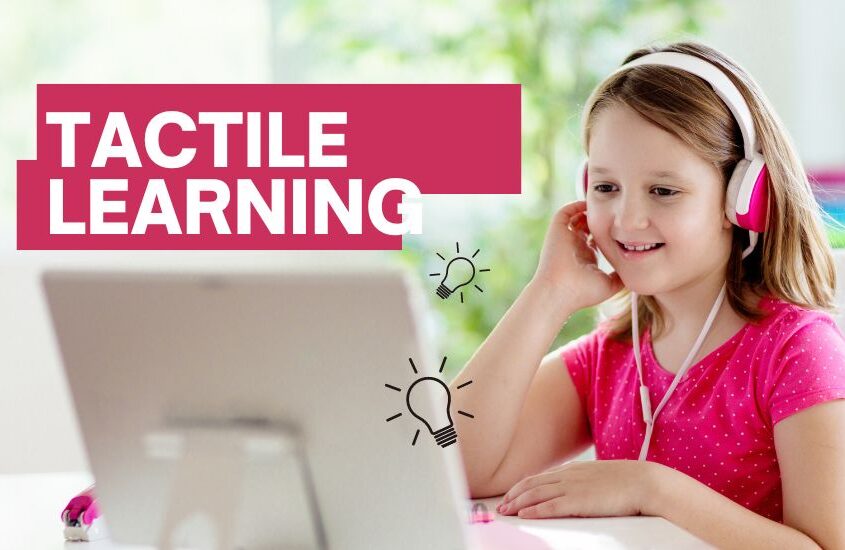Tactile Learning for Adults: Strategies for Hands-On Skill Development

Tactile learning can be beneficial for a wide range of learners, not just those who have a natural preference for hands-on activities. Research has shown that incorporating tactile elements into learning can improve overall engagement, retention, and understanding of material. This is learning helps to create a more multisensory experience, which can improve information processing and memory consolidation.
Tactile learners often have a strong preference for doing rather than just listening or reading. They tend to learn best when they are actively engaged in the learning process and may struggle to retain information. When it is presented to them in a passive or abstract way. For example, tactile learners might find it difficult to understand a complex mathematical formula unless they can see it. And manipulate physical objects that represent the variables in the formula.
There are many strategies for incorporating tactile learning into different types of learning environments. For example, teachers can use manipulatives or other physical objects to represent abstract concepts in math or science. Students can also be encouraged to use drawing or other forms of visual representation to help them visualize information and better understand complex topics.
Whether you are a student or an educator, understanding the principles of tactile learning can help you to become a more effective learner or teacher. By engaging in hands-on experiences and incorporating tactile elements into your learning environment, you can improve your understanding of complex concepts and retain information more effectively.
What is tactile learning?
Tactile learning can be beneficial for a wide range of learners, not just those who have a natural preference for hands-on activities. Research has shown that incorporating tactile elements into learning can improve overall engagement, retention, and understanding of material. This learning helps to create a more multisensory experience, which can improve information processing and memory consolidation.
There are many strategies for incorporating tactile learning into different types of learning environments. For example, teachers can use manipulatives or other physical objects to represent abstract concepts in math or science. Students can also be encouraged to use drawing or other forms of visual representation to help them visualize information and better understand complex topics.
It can also use to support the learning needs of individuals with learning differences or disabilities. For example, individuals with dyslexia or ADHD may benefit from the physical engagement and multisensory experience of tactile learning. Additionally, incorporating tactile elements into classroom environments can help to create a more inclusive learning environment that caters to a variety of learning styles.
Overall, it is a powerful tool for improving engagement, retention, and understanding of material. By incorporating tactile elements into learning environments, individuals can improve their learning outcomes and become more effective learners.
What is Tactile Learning and its benefits?
Tactile learning, also known as kinesthetic learning, is a learning style that involves physical interaction and hands-on experiences. It is a style of learning that is focused on the sense of touch and movement. Individuals who prefer this type of learning tend to be highly engaged when they can interact with the material they are learning.
The benefits of tactile learning are numerous. Research shows that it can improve engagement, retention, and understanding of material. Tactile learning helps to create a more multisensory experience, which can improve information processing and memory consolidation. This type of learning is particularly effective for individuals who struggle with more passive forms of learning, such as lectures or reading.
There are many strategies for incorporating tactile into different types of learning environments. Teachers can use manipulatives or other physical objects to represent abstract concepts in math or science. Students can also be encouraged to use drawing or other forms of visual representation to help them visualize information and better understand complex topics.

It can also be used to support the learning needs of individuals with learning differences or disabilities. For example, individuals with dyslexia or ADHD may benefit from the physical engagement and multisensory experience of learning. Additionally, incorporating tactile elements into classroom environments can help to create a more inclusive learning environment that caters to a variety of learning styles.
In summary, tactile learning is a powerful tool for improving engagement, retention, and understanding of material. It is a highly effective learning style for individuals who prefer hands-on experiences and benefit from a more multisensory approach to learning. By incorporating tactile elements into environments, individuals can improve their learning outcomes and become more effective learners.
Different types of Tactile Learning methods.
There are many different types of tactile learning methods that can use to improve engagement, retention, and understanding of material. Here are some examples:
- Manipulatives: Manipulatives are physical objects that can use to represent abstract concepts. For example, blocks can use to represent numbers or geometric shapes, and fraction circles can use to help students understand fractions.
- Games: Games can be a fun and effective way to incorporate tactile . Games like Scrabble, for example, can help students practice spelling and vocabulary while also providing a hands-on experience.
- Experiments: Hands-on experiments are a great way to incorporate tactile learning in science and other subjects. For example, students can conduct experiments with magnets to learn about magnetism or mix different substances to learn about chemical reactions.
- Art projects: Art projects can be a great way to incorporate learning while also encouraging creativity. Students can use a variety of materials, such as clay, paper, or paint, to create projects that illustrate concepts they are learning.
- Role-playing: Role-playing can be a great way to engage students and help them understand complex topics. For example, students can act out historical events or scientific processes to gain a better understanding of them.
Overall, there are many different types of tactile learning methods that can use to improve learning outcomes. By incorporating hands-on experiences into learning environments, individuals can improve their engagement and understanding of the material.
How toLearning can enhance traditional learning?
Tactile learning can enhance traditional learning by providing a more engaging and immersive experience for students. By incorporating hands-on activities, students are able to experience concepts in a way that is more tangible and memorable. This can improve retention of information and help students develop a deeper understanding of the material. Additionally, It can be particularly beneficial for students who struggle with traditional learning methods, such as reading and listening.
By providing a variety of learning experiences, including tactile learning. Educators can accommodate a range of learning styles and help students better grasp the material. It can also provide a welcome break from more traditional forms of learning. Which can help students stay engaged and motivated. Overall, by incorporating tactile learning into traditional learning environments. Educators can create a more dynamic and effective learning experience for their students.
Metal dumbbells can be a great tool for incorporating tactile learning into fitness routines. The weight and texture of the dumbbells provide sensory feedback to the user, which can enhance the learning experience. By utilizing dumbbells of varying weights, learners can explore the concept of weight and mass, and compare the sensations of holding heavy versus light objects. Additionally, the texture of the metal dumbbells can be explored to help learners identify differences between smooth and rough surfaces, while also improving their fine motor skills. Coordination exercises such as passing a dumbbell back and forth between two people can also help learners develop their coordination and timing skills. Overall, metal dumbbells provide an excellent opportunity for learners to engage in tactile learning while also improving their physical health and fitness.
How to incorporate Learning into your daily routine?
Incorporating tactile learning into your daily routine can be a fun and effective way to engage your mind and improve your understanding of the world around you. Here are some ideas for incorporating tactile learning into your daily routine:
- Use manipulatives: You can use manipulatives like puzzles or building blocks to practice problem-solving and spatial reasoning skills.
- Cook or bake: Cooking and baking can be a great way to incorporate tactile into your routine. Measuring ingredients, mixing, and kneading dough are all great ways to engage your sense of touch and learn about the science of cooking.
- Play games: Board games and card games are a fun way to engage in learning while also improving critical thinking skills and socialization.
- Take up a craft: Knitting, crochet, or other crafts can be a great way to engage in learning while also creating something beautiful.
- Go for a nature walk: Touching different textures of leaves, rocks, and other natural elements can be a great way to engage in tactile learning and connect with nature.
Incorporating tactile into your daily routine can be a fun and effective way to improve your understanding of the world around you. By engaging your sense of touch, you can create a more dynamic and engaging learning experience for yourself.
Conclusion
Incorporating tactile learning into daily routines. You can be a great way to engage in a more dynamic and effective learning experience. This learning allows individuals to connect with information on a deeper level, which can improve retention and understanding. By incorporating manipulatives, cooking, playing games, taking up a craft, or going for a nature walk. Individuals can engage their sense of touch and create a more immersive learning experience. It is a great way to accommodate different learning styles and can be particularly beneficial for individuals. Who struggle with traditional learning methods. Overall, incorporating tactile learning into daily routines is a fun. And effective way to enhance understanding and create a more engaging learning experience.


